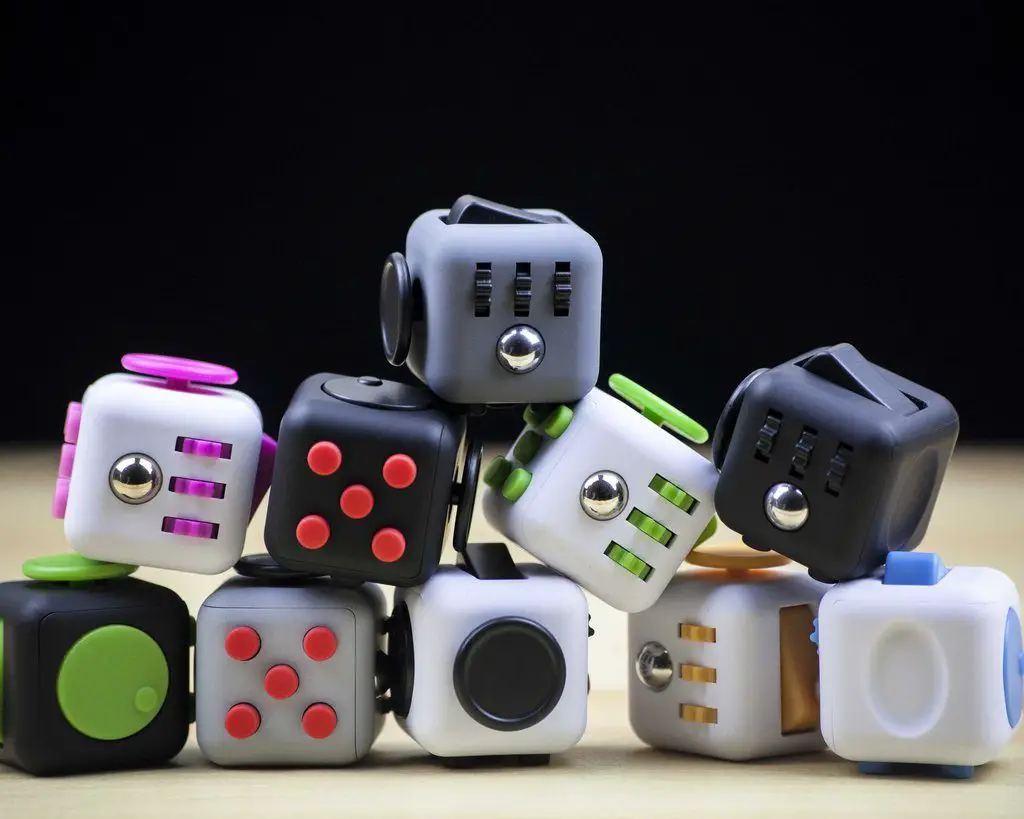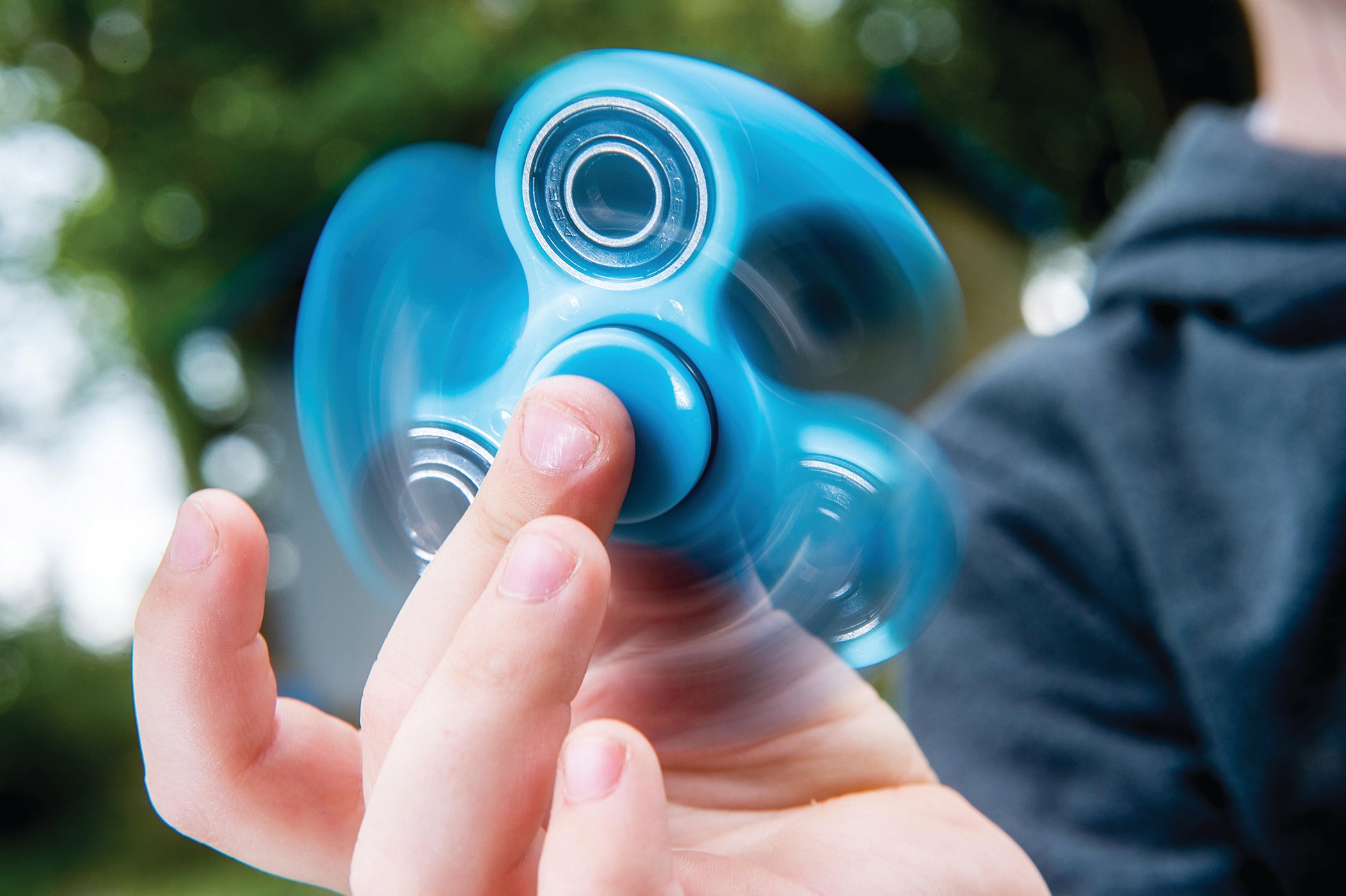One Nation, Under Fidgets
In more ways than one, the country seems to be spinning out of control.
By Kristian Porter, Northern Kentucky University
On public transportation, in classrooms, even in board meetings, fidget spinners are making appearances everywhere.
They have become a national sensation, selling out stores and Amazon marketplaces, causing kiosks to pop-up in your local mall and skyrocketing their way to the top of every eight-year-old’s wish list. With their flashy lights and bright colors, fidget spinners may seem like a fad toy, but they were originally marketed as a tool to aid those with learning disabilities and anxiety disorders, giving those prone to pen-clicking, leg-bouncing and mind-spacing something to help them focus.
The basic design of these supposed therapeutic gadgets is a triskelion shape that can be spun between your thumb and forefinger in the place of other, more distracting, nervous habits. Similar to the fidget spinner, the fidget cube has also seen overnight success, raising $6.4 million on Kickstarter, becoming one of the crowdfunding platform’s top ten most-funded projects.
Also boasting of the stress relief and concentration benefits (officially labeled a “desk toy” for its purpose of keeping you focused at work), the cube features different mechanisms on all six of its sides that the user can spin, press and flick to his or her heart’s desire.

While much of these fidget devices’ success can be attributed to the desire of young kids to collect them all, á la trading cards, there are plenty who have purchased the toys seeking their promised benefits, suggesting that fidgeting is a problem that many people are seeking a remedy for.
But why now?
The sudden popularity of the fidget spinner seems to parallel the country’s rise in anxiety in light of the 2016 presidential election. When I first saw the fidget cube, I thought the idea was genius, but that it had to be niche, only serving those select few with antsy tendencies and learning disabilities.
I thought about purchasing one at first, because I have always been a fidgeter. When I was younger, I was the kid no one wanted to sit next to, because my leg was always bouncing, a passive action that happened when I was concentrating on my school work, taking a test or anxiously trying to make my leg stop bouncing because it was a distraction to those around me.
When my leg wasn’t bouncing, my pen was tapping the desk or I was chewing on the erasers of my pencils. My body always needed to be channeling my anxious energy into something else. As a child, I thought this habit made me weird. No one else in my class seemed to have this issue, which only furthered my own anxiety.
Even though the fidget spinner was invented two decades ago by a mom trying to entertain her young daughter, the market for the product wasn’t there. Kids weren’t buzzing about these toys at school, and my younger self could not find comfort in the normalization of my nervous habits by my classmates. Because of my experiences, the idea that these fidget devices could integrate into popular culture never occurred to me.
Of course, I was wrong.
Millions of people across the world have turned to these not-quite-toys to ease their minds, and if you turn on the news or scroll through your Facebook feed, it’s pretty obvious what has everyone so on edge. Following Donald Trump’s inauguration, stress levels all across the nation were reportedly higher, and a study by Harris Poll found that 70 percent of people were worried about the future of the country.
Every day a different story breaks, relaying a new controversy swirling in the White House. Whether it’s the ongoing investigation of Trump’s ties to Russia, or the creation of a new healthcare system that could potentially label the majority of Americans as having preexisting conditions, there is plenty of uncertainty in the current state of United States politics.
Even if you agree with the president’s policies, his actions are hard to predict. The sheer ambiguity that surrounds him is enough to make anyone fear what he may say or do next. Protests have sprouted up everywhere, from the Women’s March to the March for Science to the Tax March, and tensions in households are high, creating a clear partisan divide in the country.
Gun violence is threatening the safety of communities, teen concerts are now battlegrounds for terrorist attacks and parents are losing their children to suicide at devastatingly young ages. Headlines have become a blackhole of negativity, making the world seem like a terrifying and lonely place to be.
In this context, fidget spinners found the perfect time to thrive.
The promises of these contraptions as an outlet for anxious energy is exactly what millions of Americans needed in light of the past year and a half of political unrest.
Not only are they functioning as a reimagined stress ball, but they have also provided many with much-needed relief from current events. Though they are certainly helping many, especially those with ADHD and autism, fidget spinners are trendy with the younger generation.
Not only are they popular for their fun, new colors and designs, but people are now using them to perform tricks, populating YouTube with thousands of challenge videos. One man has earned over two million views for the livestream of him spinning a fidget spinner for twenty-four hours straight, and I, for some reason, spent ten minutes of my life watching a girl create a mini fidget spinner out of acrylic and applying it to her nails (a feat that is actually really impressive).
For many, these devices are simply just fun, a new toy craze following in the footsteps of Pokemon cards and Silly Bandz. Whether for therapeutic purposes or purely recreational, fidget spinners are the distraction that everyone has been looking for, giving our brains something else to focus on while the future of our country lies in the hands of a billionaire who can’t even pronounce Nazi correctly.


















isn’t this just http://www.newyorker.com/culture/cultural-comment/the-fidget-spinner-is-the-perfect-toy-for-the-trump-presidency this article, but slightly rewritten?
Great post, Thanks for sharing!
[…] where mochi squishies come from is unknown. Unlike the fidget spinner, whose creation was credited to a Catherine Hettinger, or kinetic sand, which is trademarked by […]